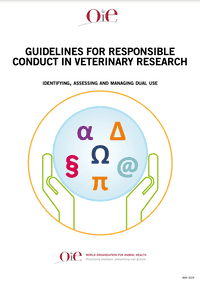Guidelines for Responsible Conduct in Veterinary Research
[Guidelines for Responsible Conduct]
Guidelines for Responsible Conduct in Veterinary Research raises awareness about potential dual-use implications of veterinary research and how veterinary professionals, researchers, and other stakeholders can effectively identify, assess, and manage those implications.
SUMMARY
The Guidelines for Responsible Conduct in Veterinary Research document is designed to raise awareness of the possibility of unintended consequences and misuse of veterinary research, and aims to support researchers and veterinary professionals in identifying and managing these dual-use implications of their work while not hindering their scientific progress. The Guidelines are not prescriptive, but rather help veterinary institutions create their own dual-use guidelines and review boards. The Guidelines walk through the risk review process throughout the research pipeline, and advocate for risk assessment of the research proposal by both a reviewing body and the funders, as well as a risk assessment of the research, analysis and publication of results. The Guidelines bring researchers, institutions, grant funders, contractors, companies, educators, publishers and regulators into the risk review process and outline how each group is responsible for parts of the pipeline.
The Guidelines were published in 2019 by the World Organisation for Animal Health (WOAH) as part of a larger biothreat reduction strategy, and are available in English. WOAH, founded as OIE, is an intergovernmental organization with 182 member countries. The organization is responsible for safeguarding and improving animal health worldwide. It is recognized as a reference organization by the World Trade Organization and maintains permanent relations with nearly 75 other international and regional organizations. WOAH champions a “One Health” approach to health security, which asserts that human and animal health are interdependent and that preventing diseases in animals is the most effective way to safeguard human health.


..png)
